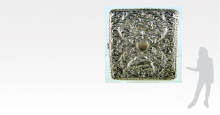
Lot
10
of
60

SILVER FROM THE INDIAN SUB-CONTINENT 1858-1947
ARTWORK DETAILS
-
-
Cutch Cheroot Case, Attributed to Oomersi Mawji
-
-
-
Silver
c.1880
Height: 10 cm
Weight: 140 g
-
Cutch in north western India is virtually an island geographically; due to this location, it developed independently from the rest of India before the 19th century and prospered both politically and culturally.
The longstanding tradition of silversmithing in Cutch developed successfully in both a commercial and artistic manner between the last part of the 19th century and the early 20th century. The "Cutch style" of silver decoration first emerged in the early 19th century and by the end of the century it had developed into a distinctive form. Where the style of decoration on silverware in Cutch originated is uncertain. Some writers point to the 15th century mosque of Ahmedabad as a major source of inspiration. The fusion of both Islamic and Hindu imagery exhibited in the intricately carved stone windows of this structure could have inspired the scrolling decoration characteristic of Cutch silver. Further to this, the Dutch influence has also been noted in the appearance of repoussé border ornamentation on the majority of Cutch silverware. There are also resemblances to the 17th century decoration of Portuguese pottery, and distinctive similarities in the depiction of animal and bird figures with Persian decorations.
The attractive ornamentation of scrolling foliage intertwined with animals, birds and hunting scenes was the most venerated style of Indian silverware in the late 19th century. Also aiding the success of the Cutch style were the supportive efforts made by the Raos of Cutch ensuring examples of the region's silverware were displayed in every possible international exhibition.
One of the reasons the Cutch artisans were capable of such intricate detailing was because the high quality of the silver used, usually between 95- 98% silver, meaning that the material was softer and easier to manipulate. Due partly to its geographical closeness, Bombay was the hub for the production, sale and export of Cutch style silverware.
The magnificent silver of Cutch owes much of its popularity to one virtuoso silversmith, Oomersi Mawji, whose grasp of the symbiosis of form and decoration, together with his superlative technique made his work internationally famous and enabled the other Cutch silversmiths to successfully market their wares.
The interest in Cutch designs subsequently flourished in London and many pieces were commissioned by companies such as the London stores Liberty & Co. and Proctor & Co. This exposure to a British clientele ensured the prosperity and popularity of the Cutch style amongst European customers from the late 19th century to the present day.
Among the most well-regarded colonial silversmiths were a small number of successful Indian designers and firms. Some of the most sought after and expensive Indian silver today are those pieces stamped "O.M." - the maker's mark of Oomersi Mawji of Bhuj, a town in the Cutch region of Gujarat, perhaps the greatest Indian silversmith of the nineteenth and twentieth centuries. Mawji founded Oomersi Mawji & Co. in 1860, and although the firm ceased operation in the 1930s, it, produced many stunning pieces, a number of which are now displayed in many of the most important museums and in important private collections around the world, and remains one of India's most celebrated silversmiths.
"During his lifetime -- from his humble beginnings as a member of the cobbler's caste in Bhuj, in the region of Kutch in Gujarat -- Oomersi Mawji became the most celebrated Indian silversmith during the Raj period, with a large international clientele. He participated in major international exhibitions and became the court silversmith to the Maharaja of Cutch. Today, scholars laud him as perhaps the greatest silversmith of the Nineteenth century."
-
Category: Jewelry
Style: Figurative
-

Height of Figure: 6'